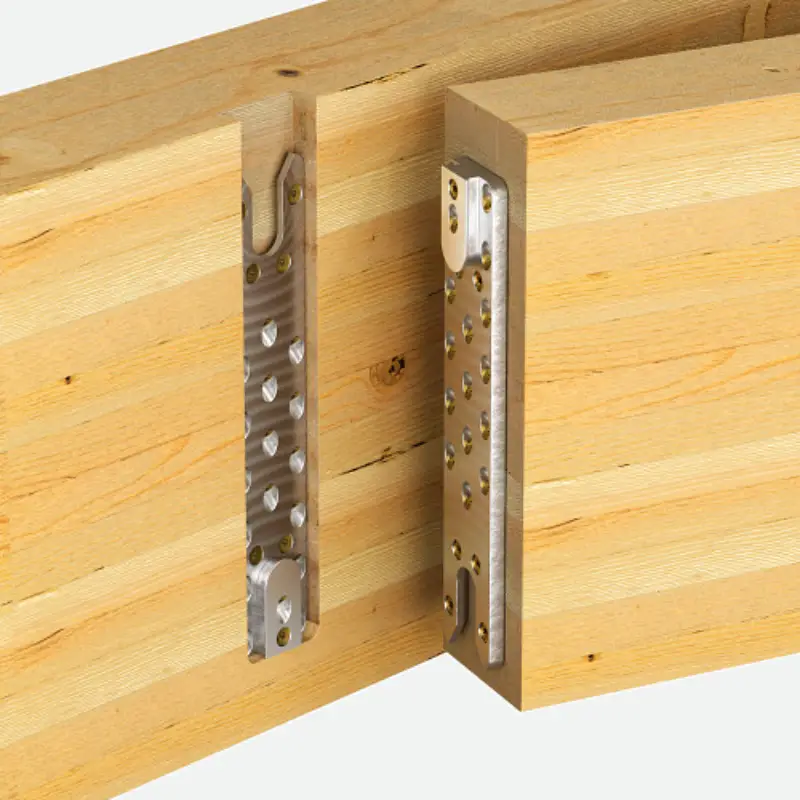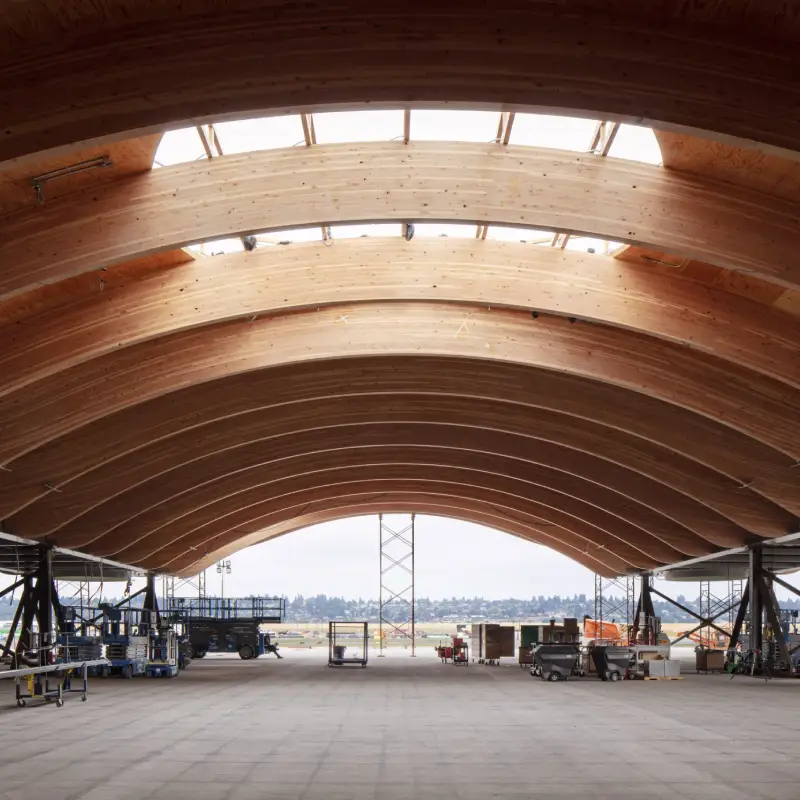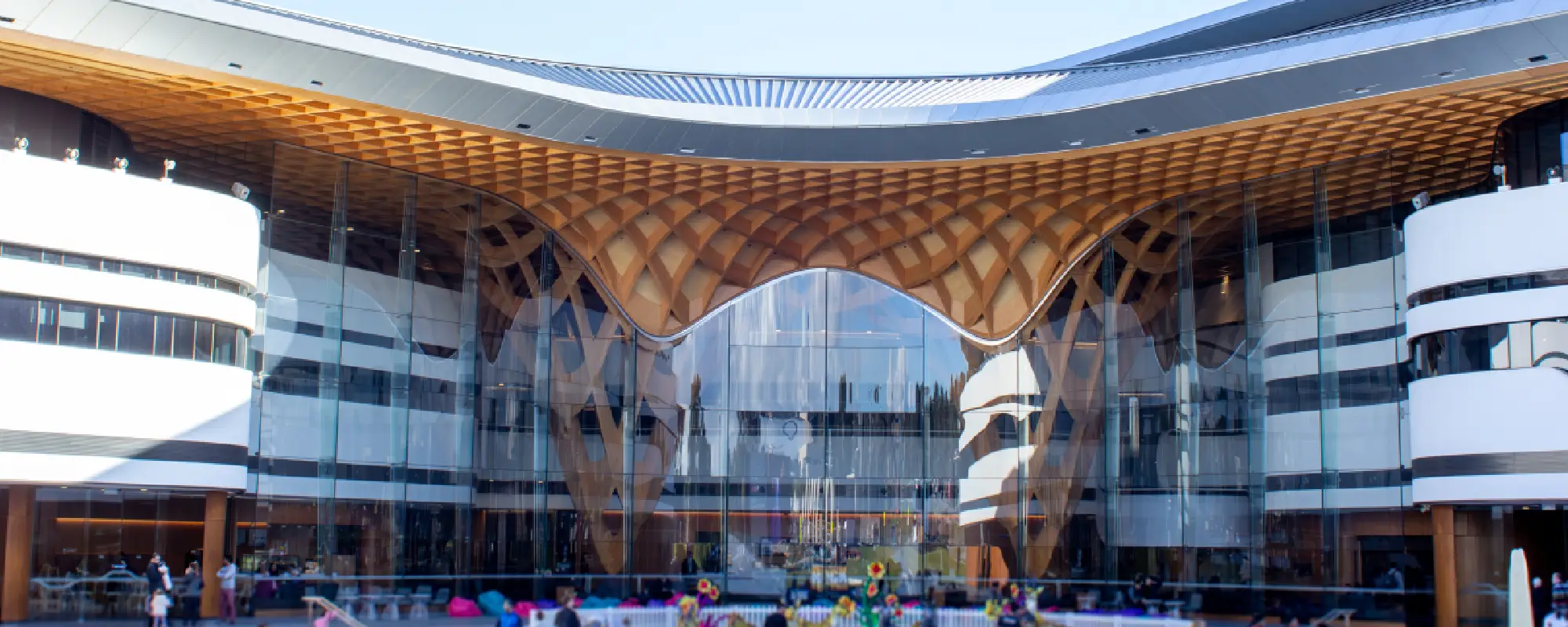VI. The Evolving Ecosystem: Innovations in Connections and Construction
The rise of mass timber is not solely a story of a new material, but also of the evolving ecosystem of technologies and processes that enable its use. Modern mass timber construction is a highly integrated, digitally driven process that represents a significant departure from traditional building methods.
The Importance of Connections
As established in seismic research, the performance of a mass timber structure is primarily governed by its connections.27 The industry has moved far beyond traditional carpentry, with specialized engineering firms developing comprehensive systems of high-performance connectors, fasteners, and adhesives designed specifically for the unique demands of mass timber.

Industry leaders like Simpson Strong-Tie and Hilti offer extensive product catalogs featuring solutions such as high-strength, fully-threaded structural screws; concealed beam hangers that provide a clean, aesthetic finish; and custom-engineered steel plates for complex geometries.33 Advances in adhesive technology have also enabled strong and reliable glued-in rod (GIR) connections for timber-to-timber or timber-to-concrete applications.34 Concurrently, research is exploring sustainable alternatives, such as the use of compressed wood dowels to create adhesive-free glulam, further reducing the environmental footprint of these products.18
The Digital Fabrication Revolution
Perhaps the most transformative technology in the mass timber ecosystem is Computer Numerical Control (CNC) milling. Mass timber components are not cut and drilled on-site; they are precision-fabricated in a factory setting directly from digital models.16 CNC machines can cut large panels and beams to sub-millimeter tolerances, creating complex joinery and pre-drilling all fastener holes with perfect accuracy.
This level of precision is fundamental to the mass timber construction process. It enables the creation of intricate architectural forms and ensures that the massive components fit together seamlessly on-site.18 It is particularly advantageous for products like DLT, where channels for mechanical, electrical, and plumbing (MEP) systems can be routed into the panels before they ever leave the factory, streamlining on-site installation.16
The Shift to Prefabrication and Assembly
The combination of engineered wood products and digital fabrication fundamentally changes the nature of the construction site. Mass timber projects are not so much built as they are assembled.12 Large, prefabricated panels and beams arrive on-site ready for immediate erection, often in a just-in-time sequence.

This industrialized approach yields significant benefits in terms of efficiency and productivity. Multiple sources report that mass timber construction can be roughly 25% faster than a comparable concrete project.15 A dramatic reduction in on-site activity accompanies this speed: estimates suggest 90% less construction traffic and 75% fewer workers are needed on the active deck.15 The result is a quieter, safer, and significantly less disruptive construction site, which is an advantage in dense urban environments.15 However, this efficiency comes with a prerequisite: intense, upfront collaboration. Because components are fabricated off-site based on a finalized digital model, all major design decisions from architects, structural engineers, and MEP consultants must be resolved and coordinated much earlier in the process than in traditional construction.20
VII. The Path Forward: Market Growth, Challenges, and the Future of Construction
Mass timber has clearly moved beyond the proof-of-concept phase and is entering a period of significant market growth. However, its trajectory from an innovative alternative to a mainstream building material will be defined by its ability to overcome a series of systemic challenges related to regulation, risk perception, and industry readiness.
Market Trajectory and Growth Drivers
The economic outlook for mass timber is strong. The global market, valued at between $3.2 billion USD and $5.25 billion USD in the 2024-2025 period, is projected to expand significantly, reaching between $9.5 billion USD and $14.82 billion USD by 2033-2034. This represents a robust compound annual growth rate (CAGR) of approximately 12.6% to 13.85%.28
Several key drivers propel this growth. The primary factor is the escalating global demand for sustainable construction materials, as developers, corporations, and governments seek to reduce the carbon footprint of the built environment.28 This demand is reinforced by the proliferation of green building certifications and government policies that incentivize low-carbon construction.36 Concurrently, continuous technological advancements in wood engineering and digital fabrication are making mass timber more capable, versatile, and cost-effective.37
Significant Hurdles to Widespread Adoption
Despite the positive momentum, several barriers stand in the way of widespread adoption of mass timber.
- Building Code Lags: The slow pace of regulatory change is a primary constraint. While the 2021 International Building Code (IBC) represents a landmark achievement by allowing mass timber structures up to 18 stories, the adoption of this code by state and local jurisdictions is inconsistent and often delayed.38 This creates a complex and uncertain regulatory landscape for developers and designers, stifling projects in regions that have not yet updated their codes.38 Federal agencies like the U.S. Department of Agriculture are attempting to accelerate this process by offering grants that incentivize local governments to adopt the latest codes.38
- The Insurance Problem: The insurance industry generally views mass timber as an emerging risk with limited historical actuarial data, particularly concerning losses from fire and water damage during construction.40 This perception of unknown risk often translates into higher premiums for builder’s risk and permanent property insurance, which can negatively impact a project’s financial viability and, in some cases, cause developers to abandon mass timber altogether.40 Overcoming this challenge will require a concerted industry effort to standardize data collection on mass timber building performance, conduct further research on repairability, and educate underwriters on the material’s proven safety characteristics.40
- Supply Chain and Cost: In North America, the mass timber supply chain is still maturing. A limited number of suppliers can lead to a cost premium compared to conventional materials, although savings from faster construction schedules often offset this.39 The industry also remains vulnerable to broader challenges such as transportation logistics, supply chain disruptions, and skilled labor shortages.37
- Industry Inertia and Lack of Experience: The construction industry is traditionally slow to change. A significant portion of U.S. construction practitioners report having little to no experience with mass timber projects.42 This lack of familiarity breeds skepticism regarding the material’s long-term durability, structural integrity, and moisture sensitivity, creating a barrier to its acceptance.36 Widespread adoption will require continued education, the development of clear design standards, and the promotion of successful case studies that demonstrate the material’s performance and benefits.
Conclusion: Building the Future with Wood
Mass timber has proven itself to be a mature, high-performance building technology with the potential to transform our built environment. Through rigorous scientific validation, it has demonstrated robust fire safety and superior seismic resilience. Through its unique ability to sequester carbon, it offers a tangible pathway to decarbonize the construction sector. And through its integration with digital fabrication and prefabrication, it points toward a future of construction that is faster, safer, and more efficient.
The journey from innovative material to industry standard is not yet complete. The future growth of mass timber hinges on a coordinated, multi-faceted effort from across the industry. This includes advocating for the swift and uniform adoption of modern building codes, collaborating with the insurance industry to develop data-driven risk models, investing in the expansion and resilience of the supply chain, and committing to the education and training of the next generation of architects, engineers, and builders. Mass timber is more than just an alternative to steel and concrete; it represents a paradigm shift toward a more sustainable, technologically advanced, and ultimately more humane way of building our cities.
Works cited
- Groundbreaking Held For Tallest Mass Timber Tower in Western Hemisphere – Urban Milwaukee, accessed September 2, 2025, https://urbanmilwaukee.com/2025/06/16/groundbreaking-held-for-tallest-mass-timber-tower-in-the-western-hemisphere/
- Milwaukee mass timber building groundbreaking, will be tallest in US, accessed September 2, 2025, https://www.fox6now.com/news/mass-timber-building-groundbreaking-milwaukee-tallest-us
- USA starts construction on world’s new tallest timber tower within days, accessed September 2, 2025, https://newatlas.com/architecture/neutral-1005-n-edison-tallest-timber-tower/
- New Design Opportunities: Mass Timber’s Transformation | ZGF, accessed September 2, 2025, https://www.zgf.com/ideas/2359-mass-timber-s-transformation
- Mass Timber – Building Construction and Materials: An Open Educational Resource Textbook, accessed September 2, 2025, https://lbcc.pressbooks.pub/buildingconstruction/chapter/mass-timber/
- What is Mass timber | Design & Construction – Naturally Wood, accessed September 2, 2025, https://www.naturallywood.com/design-and-construction/mass-timber/
- Mass Timber Products: Innovative Wood-Based Building Materials, accessed September 2, 2025, https://content.ces.ncsu.edu/mass-timber-products-innovative-wood-based-building-materials
- The Top 25 Tallest Mass Timber Buildings in the World, accessed September 2, 2025, https://gbdmagazine.com/tallest-mass-timber-buildings/
- The tallest mass timber building in the world is in Milwaukee – Wisconsin Public Radio, accessed September 2, 2025, https://www.wpr.org/economy/tallest-mass-timber-building-world-milwaukee
- World’s tallest mass timber building breaks ground in Wisconsin | Multifamily Dive, accessed September 2, 2025, https://www.multifamilydive.com/news/world-tallest-mass-timber-milwaukee/752300/
- Why is Mass Timber Becoming Popular? – Olympic Industries, accessed September 2, 2025, https://olympicind.com/article/the-rising-popularity-of-mass-timber-in-the-lumber-industry/
- 10 Prominent Examples of Mass Timber in Architecture – Keeping Forests, accessed September 2, 2025, https://keepingforests.org/10-prominent-examples-of-mass-timber-in-architecture/
- What Is the Difference Between CLT and Glulam? – Kallesoe Machinery, accessed September 2, 2025, https://kallesoemachinery.com/the-green-products-of-the-future/what-is-the-difference-between-clt-and-glulam/
- Mass Timber Construction – Building Timber Structures – Think Wood, accessed September 2, 2025, https://www.thinkwood.com/mass-timber
- Mass Timber in North America – Yale Forest Forum, accessed September 2, 2025, https://yff.yale.edu/sites/default/files/files/Marshall%20Reading%20-%20ReThinkMag-DES610A-MassTimberinNorthAmerica-161031.pdf
- Dowel Laminated Timber (DLT) Design + Construction – Think Wood, accessed September 2, 2025, https://www.thinkwood.com/mass-timber/dowel-laminated-timber-dlt
- Mass Timber Products: Innovative Wood-Based Building Materials – Southern Regional Extension Forestry, accessed September 2, 2025, https://sref.info/resources/publications/mass-timber-products-innovative-wood-based-building-materials/at_download/file
- Performance of innovative adhesive-free connections for glued-laminated timber under flexural load – hig .diva, accessed September 2, 2025, https://hig.diva-portal.org/smash/get/diva2:1917256/FULLTEXT01.pdf
- List of tallest wooden buildings and structures – Wikipedia, accessed September 2, 2025, https://en.wikipedia.org/wiki/List_of_tallest_wooden_buildings_and_structures
- How mass timber is changing design and construction – Autodesk, accessed September 2, 2025, https://www.autodesk.com/design-make/articles/mass-timber-construction
- Wood’s Fire performance | Building & Construction | naturally:wood, accessed September 2, 2025, https://www.naturallywood.com/wood-performance/fire-performance/
- 4 Things to Know About Mass Timber – Think Wood, accessed September 2, 2025, https://www.thinkwood.com/blog/4-things-to-know-about-mass-timber
- Mass Timber – American Wood Council, accessed September 2, 2025, https://awc.org/issues/mass-timber/
- Article: Mass timber for seismic zones | Resources – Naturally Wood, accessed September 2, 2025, https://www.naturallywood.com/resources/mass-timber-for-seismic-zones/
- Seismic Performance of Cross-Laminated Timber – TallWood Design Institute, accessed September 2, 2025, https://tallwoodinstitute.org/research/seismic-performance-of-cross-laminated-timber/
- Tests Highlight Seismic Resilience of Tall Mass Timber …, accessed September 2, 2025, https://www.woodworks.org/tests-highlight-seismic-resilience-of-tall-mass-timber/
- SEISMIC RESILIENT MASS TIMBER STRUCTURES USING INNOVATIVE CONNECTIONS: LATEST RESEARCH, DESIGN METHODS AND CASE STUDIES, accessed September 2, 2025, https://www.caee.ca/wp-content/uploads/2024/03/CCEE-PCEE_2023-Hashemi-024.pdf
- Mass Timber Market Size and Trends Resear2034], accessed September 2, 2025, https://www.proficientmarketinsights.com/market-reports/mass-timber-market-3855
- FAQ – Mass Timber Institute – University of Toronto, accessed September 2, 2025, https://academic.daniels.utoronto.ca/masstimberinstitute/faq/
- Using Wood for Good – How Timber Can Help Fight Climate Change, accessed September 2, 2025, https://www.creatingtomorrowsforests.co.uk/blog/using-wood-for-good-how-timber-can-help-fight-climate-change
- Fact Sheet: Mass Timber | American University, Washington, DC, accessed September 2, 2025, https://www.american.edu/sis/centers/carbon-removal/fact-sheet-mass-timber.cfm
- How can buildings act as a carbon sink? – Leers Weinzapfel Associates, accessed September 2, 2025, https://www.lwa-architects.com/research/can-buildings-act-as-a-carbon-sink/
- Cross-Laminated Timber & Mass Timber Construction | Simpson …, accessed September 2, 2025, https://www.strongtie.com/solutions/mass-timber
- Mass Timber – Hilti USA, accessed September 2, 2025, https://www.hilti.com/content/hilti/W1/US/en/business/business/trends/mass-timber.html
- Connectors and Fasteners for Mass Timber Construction Catalog – Simpson Strong-Tie, accessed September 2, 2025, https://www.strongtie.com/resources/literature/mass-timber
- Mass Timber Market Report | Global Insights 2033, accessed September 2, 2025, https://www.businessresearchinsights.com/market-reports/mass-timber-market-118905
- 2025 Global Timber Marketplace: Capitalizing on Opportunities and Navigating Challenges, accessed September 2, 2025, https://timberbase.com/2025/01/15/2025-global-timber-marketplace-capitalizing-on-opportunities-and-navigating-challenges/
- Unblock Mass Timber by Incentivizing Up-to-date Building Codes, accessed September 2, 2025, https://fas.org/publication/update-building-codes-to-use-mass-timber/
- The obstacles and opportunities of mass timber construction in the …, accessed September 2, 2025, https://www.arup.com/insights/the-obstacles-and-opportunities-of-mass-timber-construction-in-the-us/
- Mass Timber Insurance Strategy Roadmap: 2025-2030 – WoodWorks, accessed September 2, 2025, https://www.woodworks.org/wp-content/uploads/FieldEdge_MT_Insurance_Strategy_Roadmap_03.2025.pdf
- Emerging Risk: Mass timber – Allianz Commercial, accessed September 2, 2025, https://commercial.allianz.com/news-and-insights/reports/emerging-risk-mass-timber.html
- Identifying the Level of Awareness and Challenges to Adopt Mass Timber by the Construction Practitioners in the United States – ASCE Library, accessed September 2, 2025, https://ascelibrary.org/doi/10.1061/9780784483978.052
- Critical Challenges and Potential for Widespread Adoption of Mass Timber Construction in Australia—An Analysis of Industry Perceptions – MDPI, accessed September 2, 2025, https://www.mdpi.com/2075-5309/12/9/1405

